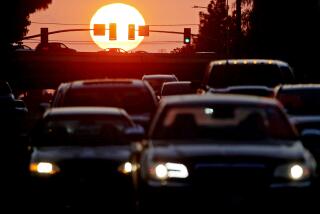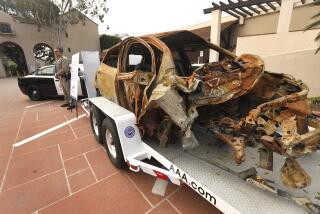Cellphone use may prolong commute time by up to 10%
- Share via
Drive. Talk. Brake. Drive. Talk. Brake.
Researchers at the University of Utah have found that motorists jabbering on cellphones drive more hesitantly than undistracted drivers and, as a result, are increasing everyone’s average drive time by 5% to 10%.
For someone with an hourlong commute each way, that translates into as much as 12 extra minutes behind the wheel each day, said psychologist David Strayer. Over the course of a year, the excess time in traffic could easily top 50 hours -- more than a typical week in the office.
“On your commute home tonight, your commute will be slower because of people who are using their cellphones,” said Strayer, whose findings will be presented Jan. 16 at the annual meeting of the Transportation Research Board, part of the National Academies of Science.
Strayer and his colleagues put 36 college students behind the wheel of a converted Ford Crown Victoria outfitted with special screens to simulate driving conditions on a 9.2-mile stretch of Interstate 15 near Salt Lake City.
Each student drove in low-, medium- and high-density traffic conditions while talking into a hands-free cellphone and again with the phone shut off.
Previous studies of dialing while driving have focused on the hazards of mixing the two. Epidemiologists examining records of accidents have found that the risk of crashing is more than four times higher for drivers on cellphones than for ones who aren’t. That’s the equivalent of driving with a blood alcohol level of 0.08%, high enough to qualify as too drunk to drive in California and most other states.
In the latest study, Strayer found that students drove 2 mph more slowly when talking on the phone and took 15 to 19 seconds longer to reach their virtual destinations.
Engaged in conversation, the students were 19% to 21% less likely to change lanes in medium-to-high-density traffic, the study said. The total number of lane changes was six, compared with seven or eight when the phones weren’t in use.
In preliminary computer models, the researchers found that those small individual changes would quickly accumulate and gum up the roads for everyone.
The National Highway Transportation Safety Administration says that 10% of drivers are talking on their phones during daylight hours, and under those conditions each freeway lane fills up with its share of motor-mouthed motorists. The overall effect is to lengthen average drive times by 5% to 10%, Strayer said.
The study is part of a broad effort by traffic engineers to identify and eliminate distractions that slow motorists down. Having all but abandoned efforts to alleviate freeway congestion by adding more lanes, they’re shifting their focus to using existing lanes more efficiently.
Freeways reach a tipping point when traffic slows to about 35 mph and cars are separated by only a few dozen feet instead of several hundred, said Hamid Bahadori, a transportation engineer for the Automobile Club of Southern California. Under those conditions, a single pokey driver will force others behind him to slam on their brakes instead of reducing their speed gradually. The more they slow down, the longer it takes to get back up to speed.
“Any slowing down sends a kind of shock wave through the traffic,” said Steven Bloch, senior traffic safety researcher for the auto club, who said he had been almost run off the road twice in two days by drivers on Interstate 405 talking on their cellphones.
Some traffic experts were skeptical that the patterns seen in the driving simulator would be repeated on real roads. They also noted that though some lane changes improved traffic flow, they weren’t always beneficial.
Sometimes drivers think an adjacent lane is moving faster, only to find after merging that they want to move back, slowing things down even more.
“If by using the cellphone you don’t do that, then you’re helping,” said Petros Ioannou, director of the Center for Advanced Transportation Technology at USC.
But Strayer said there was more at stake than wasted time. Chatty drivers also mean more gasoline consumption, more pollution and worse health.
“When people are stuck in traffic, their blood pressure -- especially for males -- starts to really go up,” he said.
--







